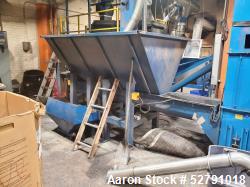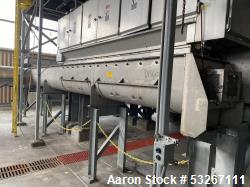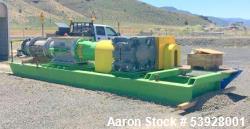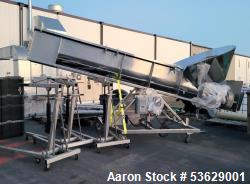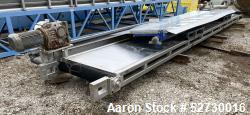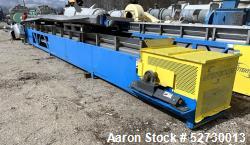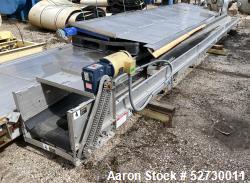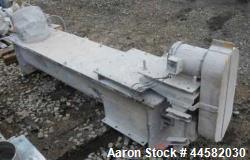Used Conveyors
Aaron Equipment Company buys and sells reconditioned, unused, and used conveyors. Conveyors are used for loading and unloading trucks and moving packages or other items through facilities or along assembly lines. Depending on the load and application, conveyors are configured by the manufacturer by the number of wheels and the spacing of the wheels. It is important to consider the size, flowability, abrasiveness, corrosiveness, moisture content, and the temperature at which it must be kept before deciding on a conveyor system that suits your company’s needs. Distinct types of conveyors include belt, pneumatic, and screw.
Belt conveyors consist of pulleys with a closed loop of carrying something from one place to another. It rotates about while one or both pulleys are powered, which moves the belt forward. The main industrial classes of belt glasses include material handling and bulk material handling. Pneumatic conveyors use pipes or ducts that carry materials and a stream of air. Because of this, the materials are free flowing materials like cement. Using air pressure, products are moved through tubes, and items are pushed from one entry point to an exit point. Screw conveyors use rotating helical screw blades to move liquid or granular materials. Typically, they are used horizontally and in bulk handling industries. They are an efficient way to move semi-solid materials, like food waste, wood chips, cereal grains, meat, and more.
If you are looking to sell your used conveyors submit a request online or contact Erik Eichert at 630-238-7480.
Your guide to industrial conveyors
Industrial conveyors are essential tools in factories and warehouses, helping to move goods efficiently from one point to another. Whether transporting raw materials, finished products, or anything in between, conveyors can easily handle large volumes of goods. In this guide, we'll explore the various types of industrial conveyors and how they contribute to industrial automation.
Understanding Industrial Conveyors
Conveyors come in many shapes and sizes, each designed to meet specific needs in the industrial sector. Some of the most common types include belt conveyors, screw conveyors, and spiral conveyors. Let's dive into each type to understand their applications and benefits.
- Belt Conveyors are among the most used types of conveyors. They consist of two or more pulleys and a continuous loop of material—the conveyor belt—that rotates around them. The pulleys power the belt, moving materials along the conveyor line.
- Applications of Belt Conveyors: Various industries use belt conveyors, including manufacturing, food processing, and mining. They are ideal for transporting lightweight to heavy materials over long distances.
- Advantages of Belt Conveyors:
- Efficiency: They allow for the continuous movement of materials, reducing the need for manual handling.
- Versatility: Suitable for transporting various materials, from small packages to bulk goods.
- Customizable: Available in different sizes and configurations to fit specific applications.
- Screw Conveyors consist of a helical screw blade, also known as a "flighting," that rotates within a tube or trough. As the screw rotates, it moves materials along the conveyor path.
- Applications of Screw Conveyors: Screw conveyors are commonly used to transport bulk materials like grains, coal, and cement. They are instrumental in industries where materials must be mixed or controlled in volume as they move.
- Advantages of Screw Conveyors:
- Compact Design: Ideal for spaces where a straight conveyor belt wouldn't fit.
- Controlled Movement: Allows for precise control over the amount of materials.
- Versatile: Can handle a variety of materials, from powders to granules.
- Spiral Conveyors are vertical conveyors that transport items up or down in a spiral path. They are perfect for moving products between different levels of a facility.
- Applications of Spiral Conveyors:Packaging and distribution centers often use spiral conveyors. These efficient machines move products from one floor to another without taking up much horizontal space.
- Advantages of Spiral Conveyors:
- Space-Saving: Their vertical design saves valuable floor space.
- Smooth Flow: They ensure a continuous flow of materials with minimal disruption.
- Versatility: Suitable for handling different items, including cartons and packages.
Role of Industrial Conveyors in Automation
Industrial automation relies heavily on conveyors to streamline processes and reduce manual labor. Conveyors help automate the movement of materials, which is crucial for maintaining efficiency and productivity in modern manufacturing and processing facilities.
Benefits of Automation with Conveyors
- Increased Productivity: Automated conveyors allow for faster processing and handling of materials.
- Reduced Labor Costs: By automating material handling, companies can reduce the need for manual labor, lowering operational costs.
- Enhanced Safety: Automation minimizes the risk of workplace injuries by reducing manual handling of heavy or hazardous materials.
Choosing the Right Conveyor System
When selecting a conveyor system, it's essential to consider factors such as the material being moved, the required speed, and the available space. Here are some tips to help you choose the right conveyor system:
- Assess Your Needs
- Determine the types of materials you need to move and their respective weights and sizes.
- Consider the distance over which the materials need to be transported.
- Evaluate the available space in your facility to determine the best conveyor configuration.
- Consider the Environment
- Consider your facility's working conditions, such as temperature and humidity.
- Consider any special requirements, such as washdown capabilities in food processing plants.
- Evaluate Cost and Maintenance
- Factor in the initial cost of the conveyor system and its installation.
- Consider the long-term maintenance requirements and costs.
- Maintaining Your Conveyor System
- Regular maintenance is crucial for keeping your conveyor system running smoothly. Here are some maintenance tips:
- Regular Inspections: Periodically check for wear and tear, misalignment, and other issues.
- Lubrication: Keep moving parts well-lubricated to prevent friction and wear.
- Cleaning: Regularly clean the conveyor system to prevent the buildup of debris and contaminants.
- Regular maintenance is crucial for keeping your conveyor system running smoothly. Here are some maintenance tips:
Industrial conveyors are indispensable in modern manufacturing and processing facilities. Choosing the correct conveyor type and maintaining them can enhance efficiency, reduce costs, and ensure a smooth flow of materials in your operations. Whether you're looking to automate your facility or improve your material handling processes, conveyors offer a reliable and effective solution.
With this guide, you know how to make informed decisions about industrial conveyors and their role in automation. Whether you're considering a belt conveyor, screw conveyor, or spiral conveyor, understanding their benefits and applications will help you optimize your operations for success.
